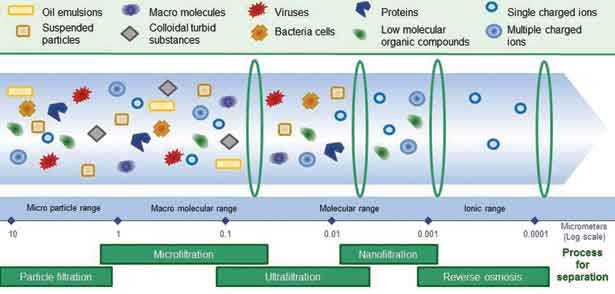Nội dung
MÀNG LỌC CERAMIC TRONG XỬ LÝ NƯỚC THẢI

Ceramic water filtration mechanisms can help businesses conserve water and save money.
Filtration System Basics
Polymer or ceramic tubular membranes are currently used to clean, conserve and reuse water in a variety of industrial and communal wastewater applications, including wastewater plants, buildings, and even cruise ships. Currently, polymer membranes account for around 75% of the membrane filtration market, with ceramics accounting for the majority of the remaining 25% (along with a small number of other materials, such as metallic membranes). Figure 1 illustrates the variety of filtration separation processes available and provides an overview of their use in particular applications.
The use of ceramic membranes is common in dairy production and fruit juice clarification, whereas polymers currently dominate the wastewater treatment sector. Due to their lower purchase price, systems using polymer membranes are widespread in the wastewater filtration market. However, while polymer membranes are cheaper to manufacture than their ceramic equivalents, polymer systems require more frequent filter replacements.
Compared to ceramic membranes, the low resistance properties of polymer membranes limit the number of applications in which they can be used. In general, the ceramic membrane filtration module housing, which is often metallic, sets the limitations for processing aggressive media, rather than the filter itself. Inversely, when polymer membranes are used in harsh environments, the filter material will wear first. In addition, the flow rate through ceramic membranes can be greater than through polymer membranes for a given pore diameter. A ceramic filtration unit also requires a lower pressure (and less energy) to circulate fluid.
As water reuse becomes a more important issue, some extremely demanding industrial applications are faced with the need to filtrate increasingly challenging media. Due to the ceramic materials’ superior chemical and abrasion resistance, their use is preferred over polymer membranes for some applications. One example is the separation of oil, water and sand in the oil industry—a process that is both chemically aggressive and abrasive.
While ceramics can withstand pH values ranging from 0-14, polymer membranes can only withstand a much narrower pH range; they can be tailored to resist neutral, acid or basic pHs, but generally not all three ranges with the same material. Ceramic membranes are also better for high-temperature applications. They can be sterilized or steam-cleaned for specific applications, such as in the medical industry, which is not possible with polymers. Moreover, ceramics have more strength and rigidity, giving them better dimensional stability under pressure than polymer materials.
In the filtration of water containing oils or fatty acids (e.g., surfactants), emulsion-breaking chemical dispersants are often required to limit the formation of an organic fouling layer on the surface of polymer membranes. High-quality ceramic membranes have been found to be more resistant to fouling without the need for dispersant additives.
While the fouling of both ceramics and polymers is inevitable, ceramics can enable a wider range of options when it comes to systems with a clean-in-place (CIP) process. In some applications, membranes have to be cleaned with harsh chemicals and be able to withstand high pressure from two directions. This is especially necessary during back-flushing to prevent the formation of a fouling layer to the membrane’s surface or in the pores, leading to a reduction in the membrane’s filtration capability.
For example, peroxide chemical cleaners or high-temperature steam cleaning is acceptable for ceramics, but can be an issue for polymers. A combusting, high-temperature air cleaning treatment can be used for ceramics but would likely melt a polymer membrane. CIP operations can be performed automatically without interrupting the filtration process when ceramic membranes are used, but this is more difficult with polymeric membranes.
At the same time as industries are adopting water reuse and conservation methods, they are trying to reduce the footprint of such activities on their facilities. Membrane selection and design plays a part in reducing facility footprint in the businesses or communal buildings using these systems. Newly developed ceramic membranes can achieve a great compactness (increased surface area of membrane per volume unit) due to the versatility of their design and geometry. Compactness and improved design of ceramic filtration modules also contributes to increasing the energy efficiency of such systems.
Applycations:
- Emulsion waste water in steel industry
- Waste water from Bankote Printing works
- Oily waste water in Auto industry
- Cutting and Degreasing fluids from machinery industry
- Mine water & Condensate water
- Alkaline and acid processing stream liquid
- Waste with pigment from printing&dyeing of high COD/BOD
- Landfill leachate water
- Electroplate waste,Laundry waste water.
- Grinding water micro-electronics
